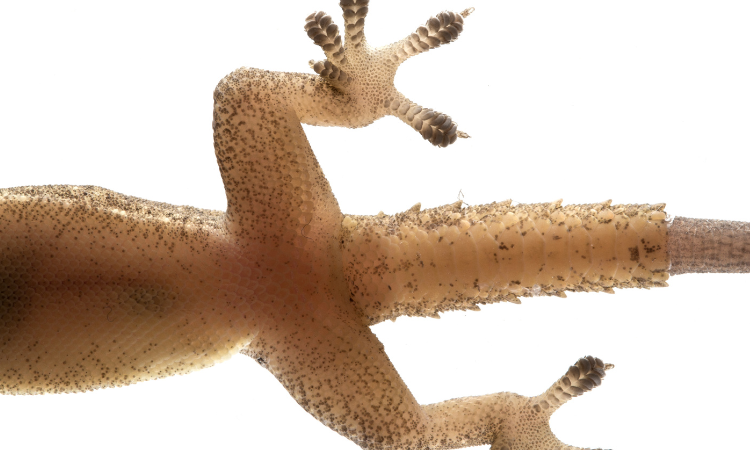feet are an important part of a gecko’s anatomy. they not only help the gecko move, but also provide grip when climbing and clinging to surfaces. But how do these amazing little feet work? Read on to find out!

Gecko feet have millions of tiny hairs called setae that allow them to stick to surfaces
Geckos are some of the most fascinating animals due to their unique ability to attach and detach themselves from walls and ceilings. This superpower is enabled by millions of tiny hairs, called setae, located on gecko feet.
These specialized hairs can create an immense amount of grip and adhesion that mostly relies on van der Waals forces, or weak electrostatic attraction between gecko’s feet and any type of surface.
This mechanism allows geckos to stick to surfaces upside-down or climb them with ease. Amazingly enough, geckos can generate sufficient force that its foot pad can bear their own weight multiple times without loosing attachment.
All in all, gecko’s setae give them a huge advantage in many aspects like hunting and evading predators.
The setae are so small that they fit into the microscopic pores on surfaces
The gecko is an incredible creature, possessing the remarkable ability to climb almost any surface regardless of how smooth it may be. This extraordinary feat is made possible by millions of small setae located on each gecko’s toes and feet.
These microscopic setae fit into the miniscule pores that cover even very slick surfaces, providing geckos with an extremely effective grip. Acting like tiny suction cups, geckos can pursue prey across walls and windows without ever slipping or losing their footing.
Thanks to these remarkable setae, geckos have been able to thrive in all types of environments.

When the gecko lifts its foot, the setae release from the surface and pull back into place
The gecko is a remarkable creature; it has a unique ability to stick and unstick itself seemingly at will. How is this possible? Researchers have found geckos release small microscopic structures called setae from the bottom of their feet when they lift them up, creating an incredibly strong bond with any surface.
When geckos want to become un-stuck, they simply lift their feet – causing the setae to retract back into place – allowing for no drag or force as the gecko moves away. Take a moment to appreciate this remarkable natural phenomenon!

This process happens very quickly, and allows geckos to climb walls and even walk upside down!
Geckos are quite impressive creatures, capable of performing unique and astonishing feats – their ability to climb walls and even walk upside down is made possible by an amazing process that happens in a very short amount of time.
When geckos come into contact with a surface, they use special microscopic hairs on their toes called setae which stick to the surface with adhesive force created through Van der Waals forces.
On top of this, geckos can quickly increase or decrease the sticking power at will, allowing them to bring their feet up without any resistance for an easy detachment as well as attach onto surfaces for an incredible grip.
Through the coordination and optimization of these two processes – adhesion and quick detachment – geckos are able to move up vertical surfaces with ease.
In conclusion, geckos have a unique ability to cling to surfaces due to the millions of tiny hairs on their feet called setae. These hairs fit precisely into the microscopic pores on surfaces and as they lift their feet, the setae pull back into place.
This incredible process happens in a fraction of a second which has allowed geckos to innovate and develop ways of moving that are otherwise unheard of in other animals. It is with this striking ability that the gecko manages to surprise us all; from climbing walls to even walking upside down!
Truly, this is an animal that never fails to amaze!
Related posts:

Hi – I’m Erika, the lead gecko enthusiast here at Geckopedia! I write articles about pet geckos, including what to feed your leopard gecko and how to help your pet gecko live a long, happy life! I graduated with advanced degrees from UC-Berkeley, the University of Southern California (USC) and Indiana University-Bloomington, where I studied Biology and Animal Science. I use my experience to help others learn about gecko care, and I am an advocate for all topics gecko related!
